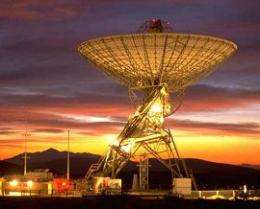School Kids Track LCROSS

Using a colossal radio telescope in the Mojave Desert, school kids around the world are helping NASA track the LCROSS spacecraft as it heads for a crash landing on the Moon.
On Oct. 9th, LCROSS will smash into the inky-dark shadows of a crater near the Moon's south pole in search of water. Eager youngsters are locked on to LCROSS's signal as intently as they've ever viewed a video game, and they're feeding NASA valuable data about the spacecraft's health and status.
Students attending 283 schools world-wide are participating in the Goldstone Apple Valley Radio Telescope Project, or GAVRT -- a joint project between NASA's Jet Propulsion Laboratory and the Lewis Center for Educational Research. Boys and girls control the behemoth telescope via the internet and they have been learning how to do radio astronomy just like real mission scientists.
Brian Day of NASA Ames Research Center explains how the students "adopted" LCROSS.
"Because LCROSS has a very steeply inclined orbit, we have only a 2-hour window once every 3 days when we can check out the spacecraft using the Deep Space Network. So we decided to ask GAVRT for help. These kids help us get extra listening time for our spacecraft, and they get an incredible educational experience in return."
Lewis Center founder Rick Piercy is the visionary who sparked GAVRT's creation, making this extraordinary hookup possible.
"In 1994, I heard that NASA was decommissioning a fully functional radio telescope," says Piercy. "I knew that this particular telescope had been used to communicate with the Apollo spacecraft and realized that it was something special. I wanted it for the students at our school, the Academy for Academic Excellence. I figured we could load it up in a couple of pickup trucks and bring it to the school if we could get permission."
He called California Congressman Jerry Lewis, who put him in touch with then-NASA Administrator Daniel Goldin. Piercy convinced Goldin and NASA to give the telescope to the school and make the instrument available to students nationwide.
"I contacted Dr. Michael Klein, who was a foremost authority on Jupiter radio astronomy but has since passed away. When I told him that I wanted to go load up the telescope in a truck to bring to the school, he got very quiet and then said, 'The scope is 110 feet wide, weighs almost a million pounds, and is 9 stories tall.'"
Piercy's response? "Oh."
The telescope stayed where it was, but that didn't stall Piercy's plans. "Our school became the first to take over a NASA telescope," he says. To date, 38,000 students, including boys and girls at Department of Defense schools across the globe, have run the telescope. NASA scientists and Lewis Center staff train teachers. In turn, the teachers train groups of students.
"Best of all, the scientists mentor the students - answering questions and offering guidance as needed."
According to Piercy, one mother was a little worried at first, saying, "I don't even let my daughter run the washing machine -- and she's going to operate a 15 million dollar piece of NASA equipment?"
No worries, mom. It's all done remotely. Piercy never had to test his pickup truck. Students access the massive radio telescope, which resides at the Goldstone Tracking Station in California's Mojave Desert, via the Internet in their classrooms.
"Dr. Klein used to say that looking at a radio signal on a screen was about as thrilling as watching the grass grow," says Piercy. "But the kids love it because they're participating in real space missions and learning from NASA scientists what those signals mean."
If a problem occurs with LCROSS while NASA isn't able to listen, students at one or more of the participating schools may know it first and can alert the space agency.
"The kids realize how important they are to the mission's success," says Piercy. "Besides, it's fun."
"I'm really excited about being able to do this," says Anthony Cole, a ninth grader at the Academy for Academic Excellence. "It's a once in a lifetime opportunity to be able to track a spacecraft looking to find water on the Moon."
"Kids learn best by participating -- using all their senses," explains Piercy. "The proof's in the puddin'. The students at our school have had the highest standardized high school test scores in the county for several years now. Results for this year aren't out yet, but we expect similar success."
Students, including homeschoolers, who want to join in the fun can sign up at LewisLearning.org. There's room for everyone -- the Lewis Center is equipped to handle more than 60 million students from anywhere in the world. All you need is a speaker phone and a computer connected to the Internet.
And how's this for thrilling? There are plans in the works for GAVRT students to help listen for communications from extraterrestrials.
"Is there anybody out there?"
Yes. 38,000 clever kids hearing you loud and clear! Wassup?
Source: Science@NASA, by Dauna Coulter



















